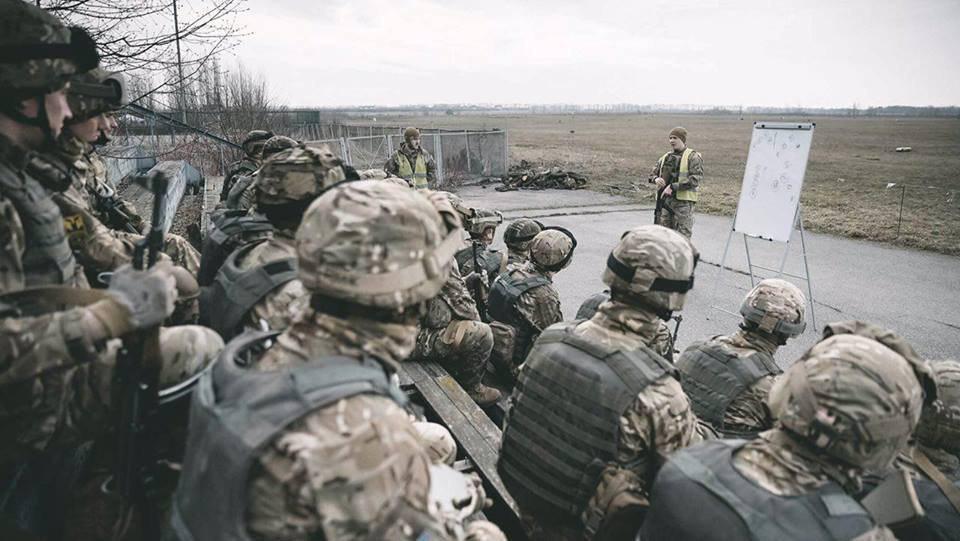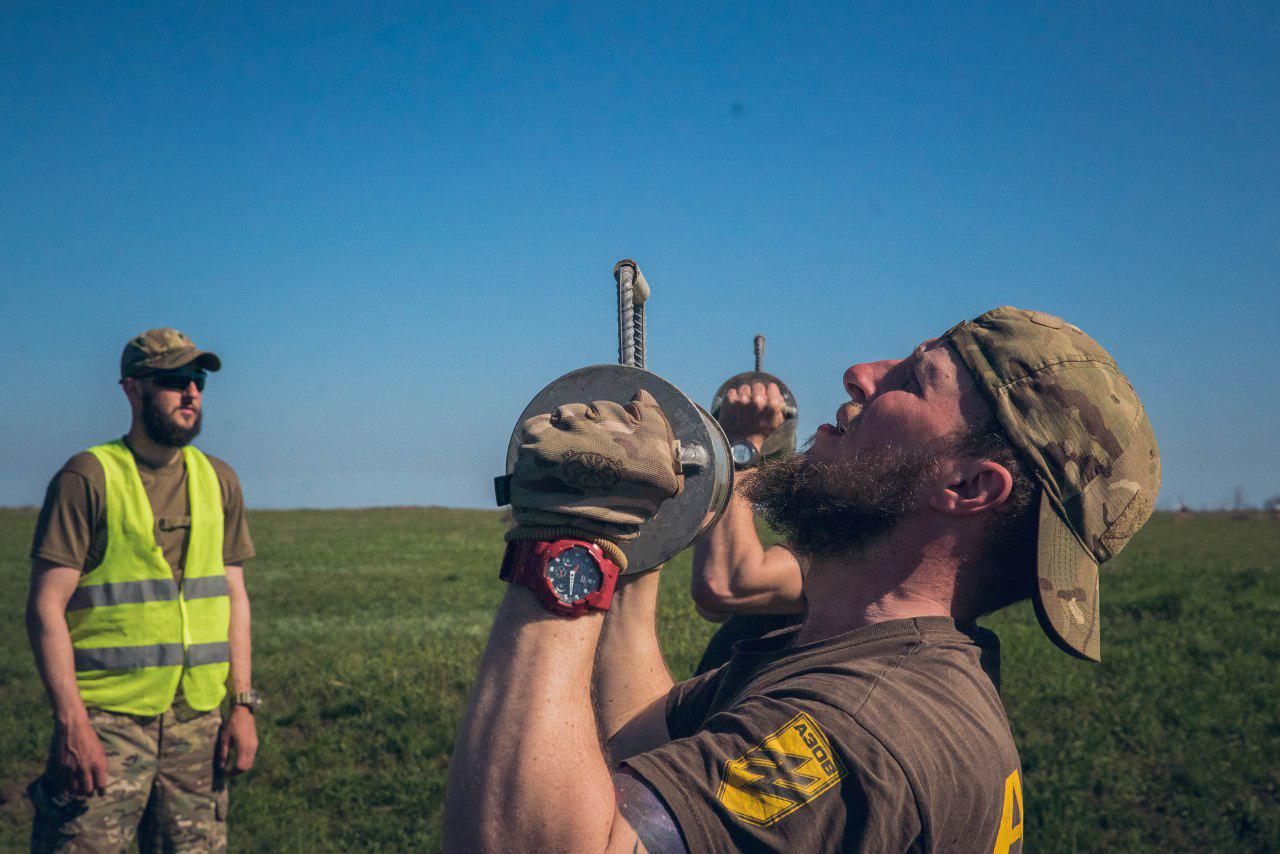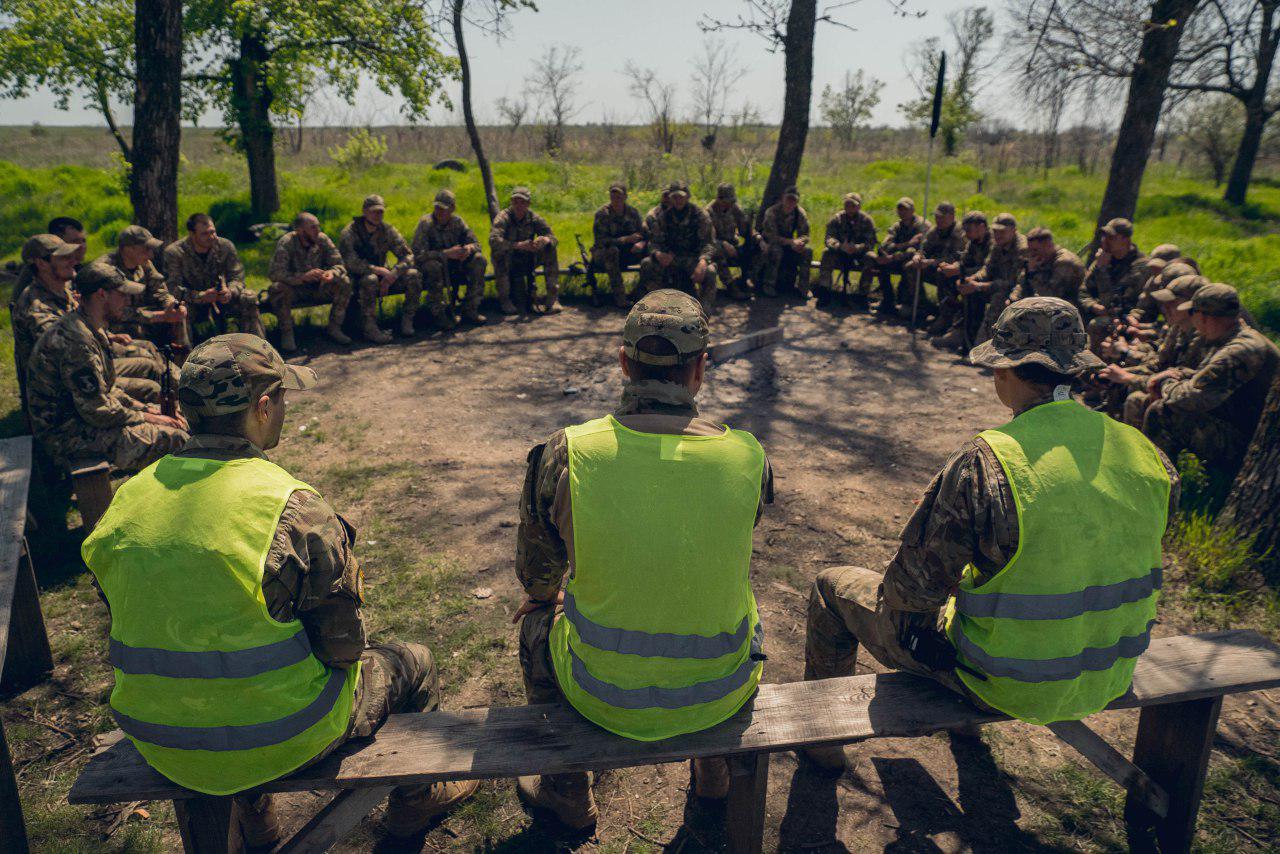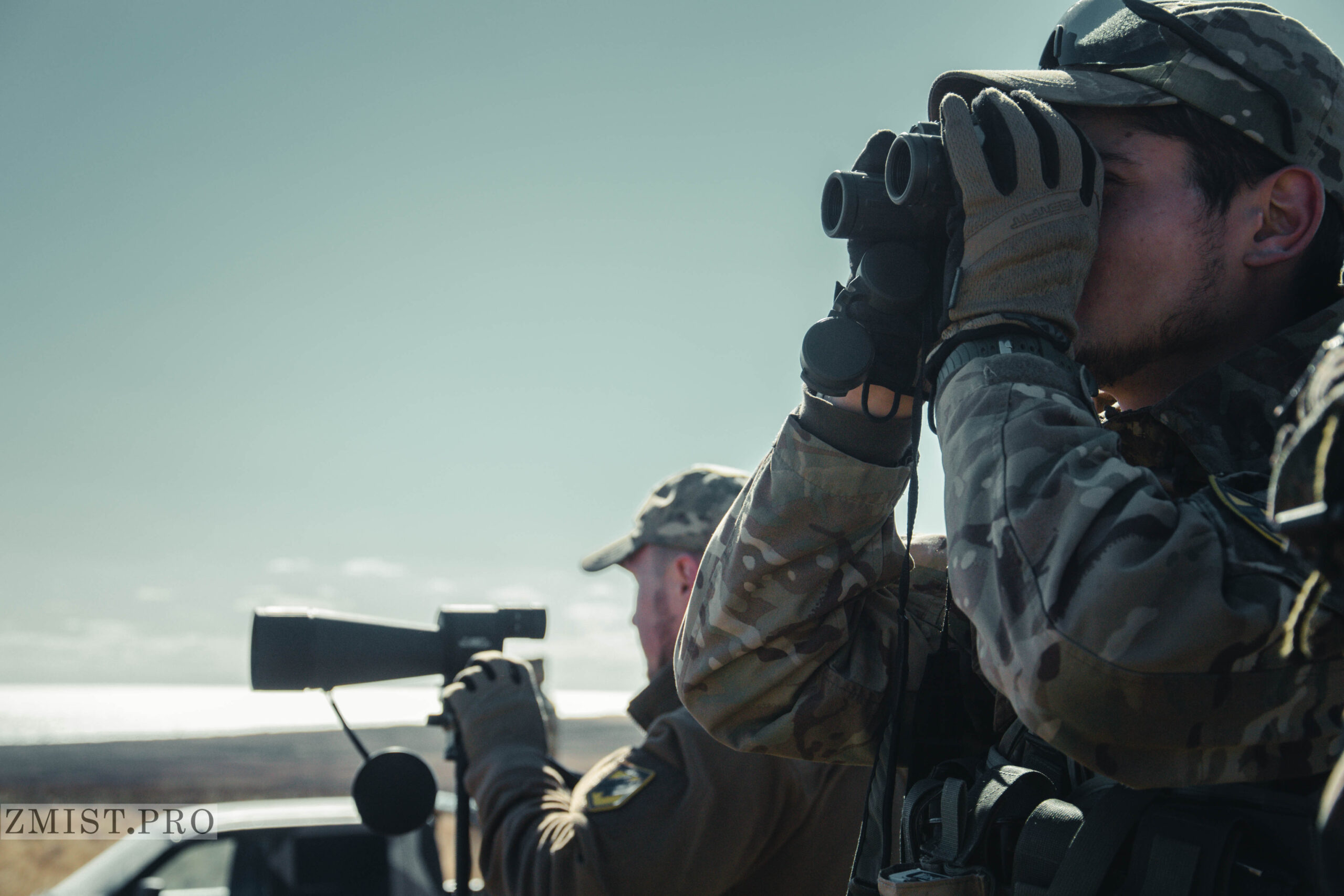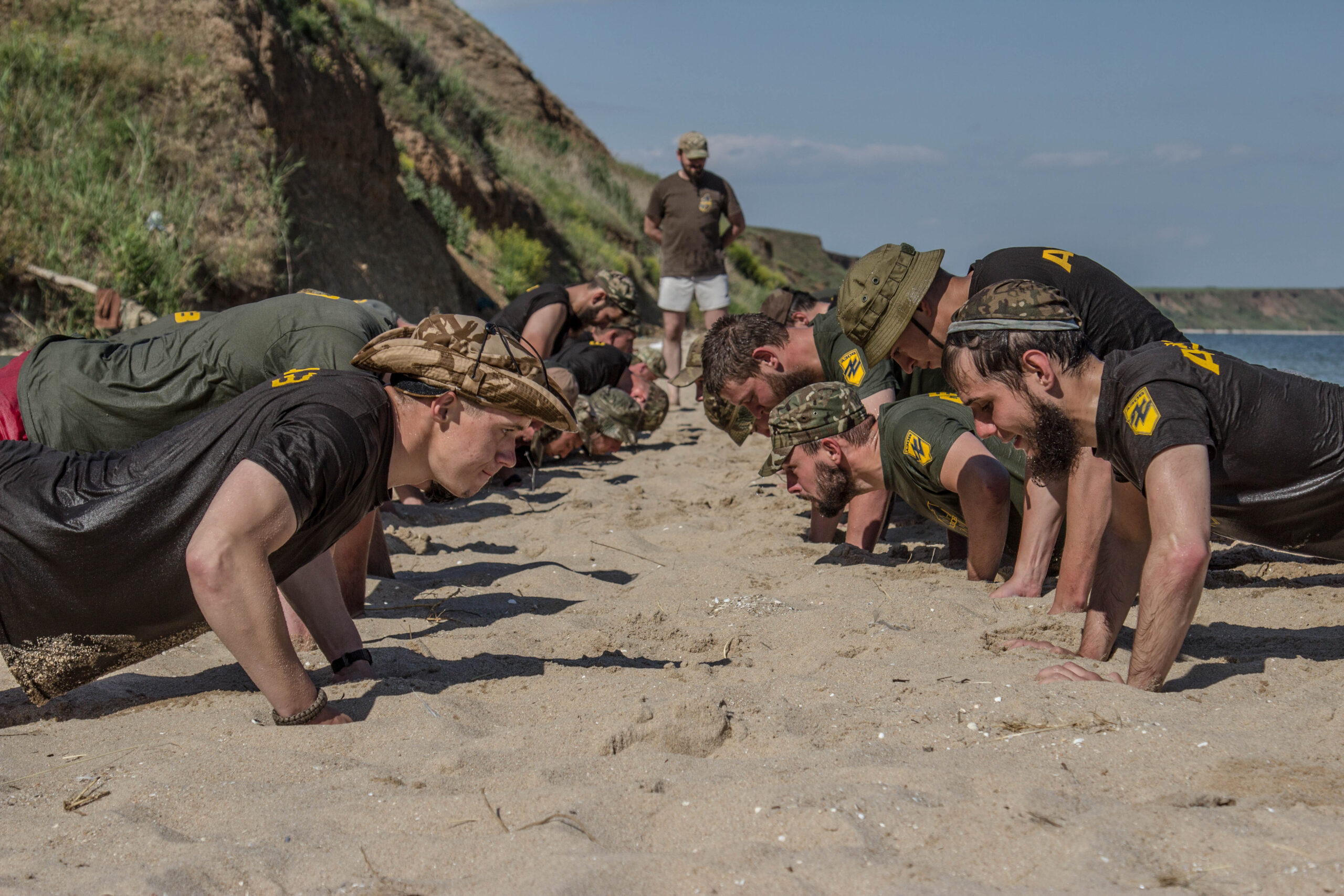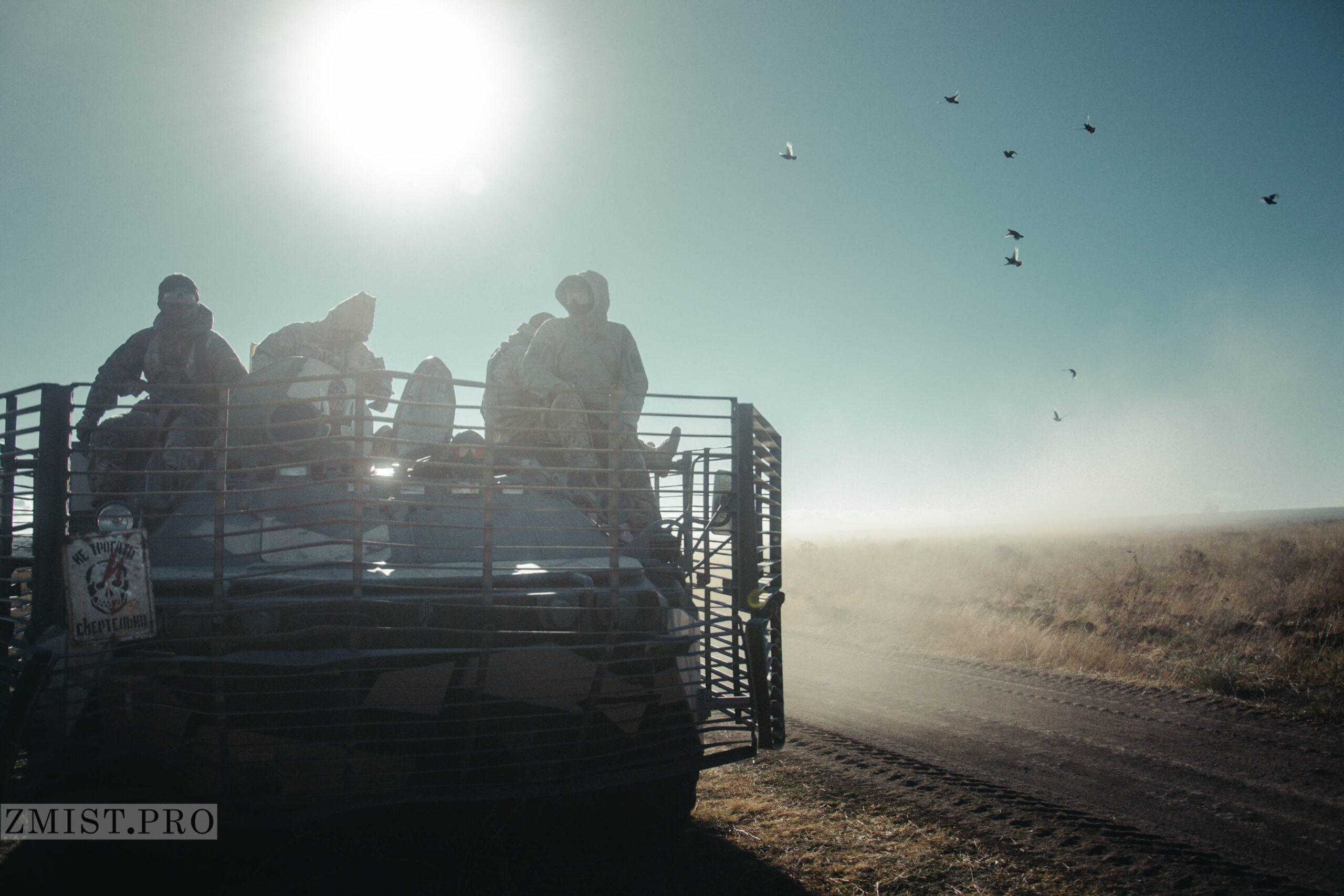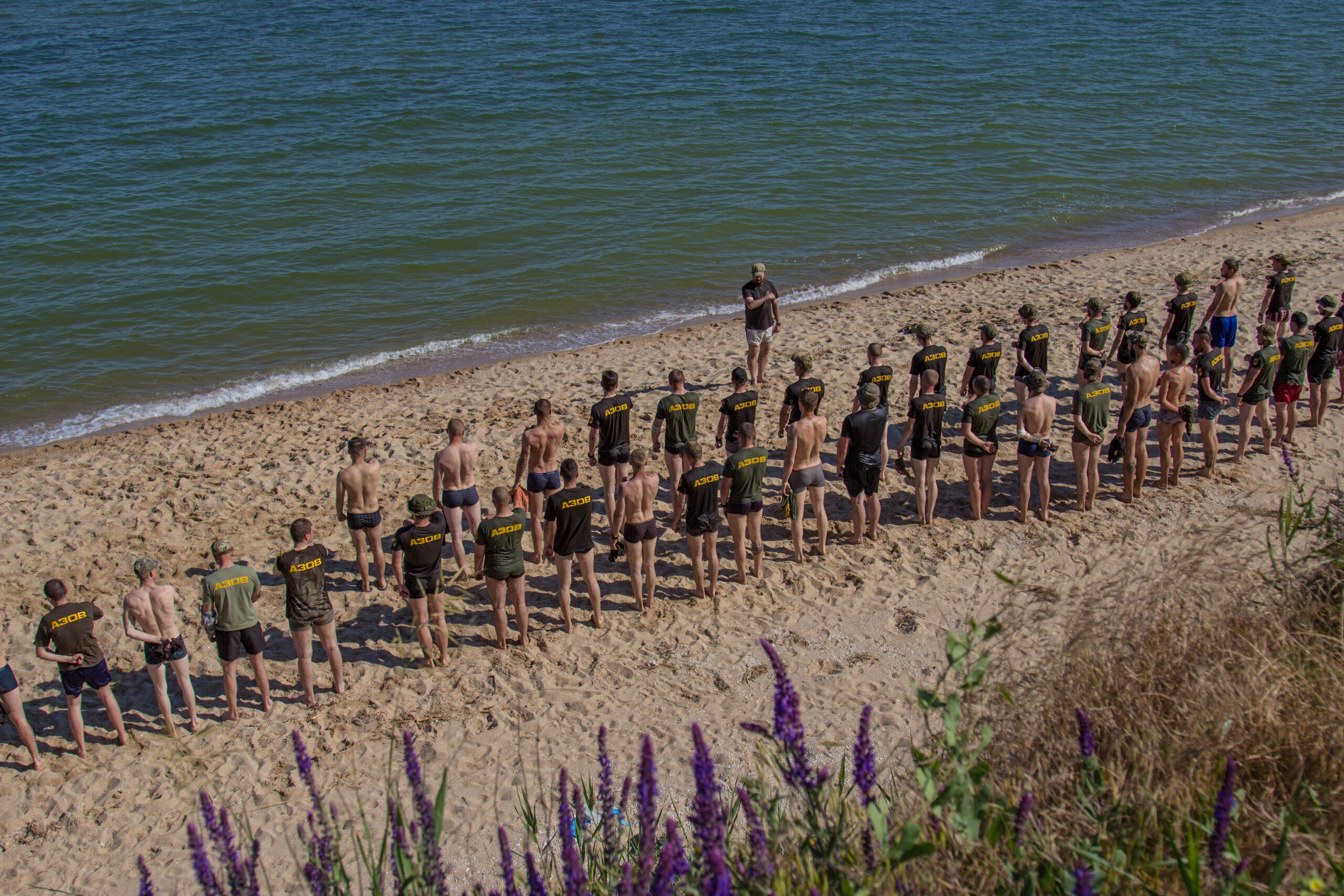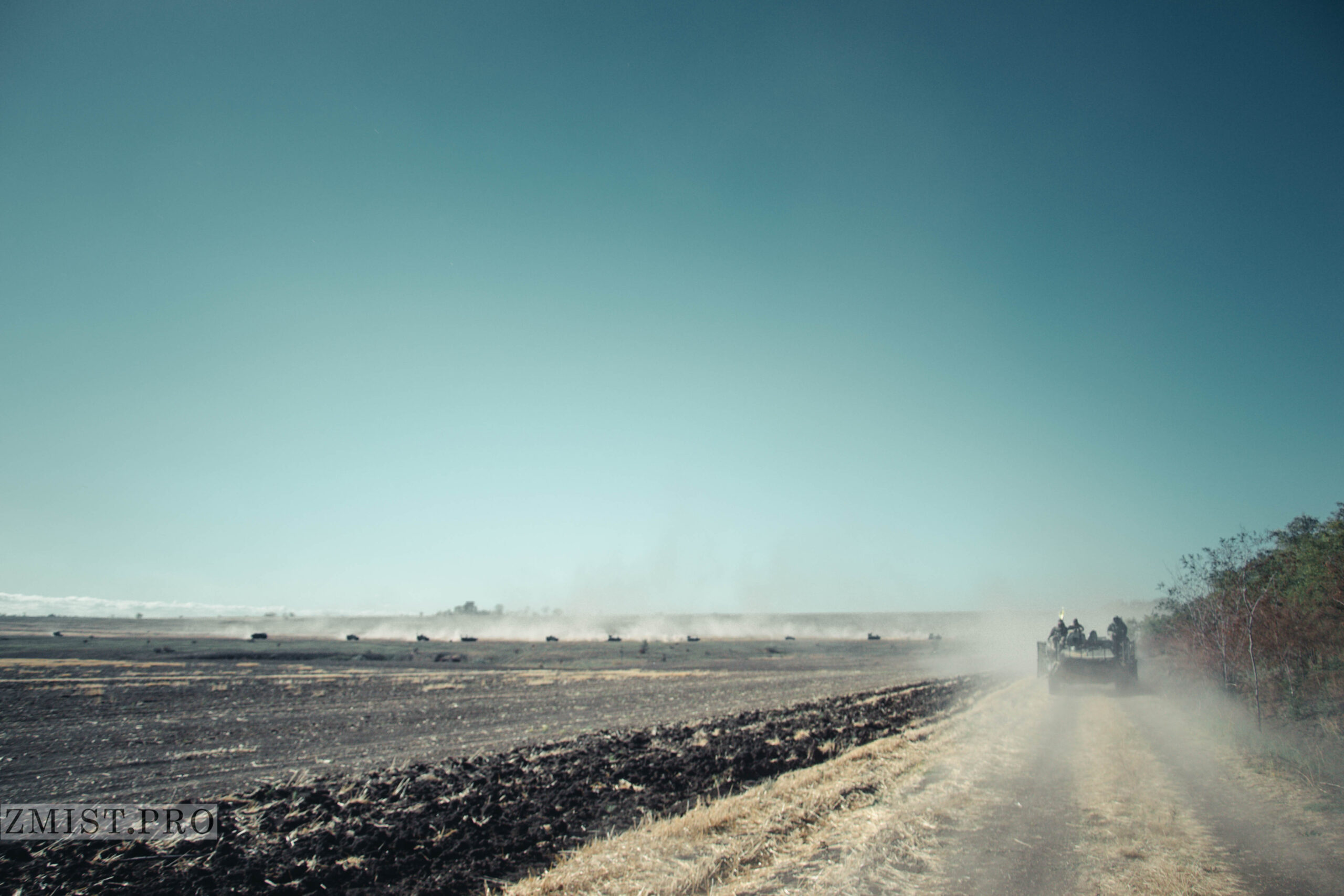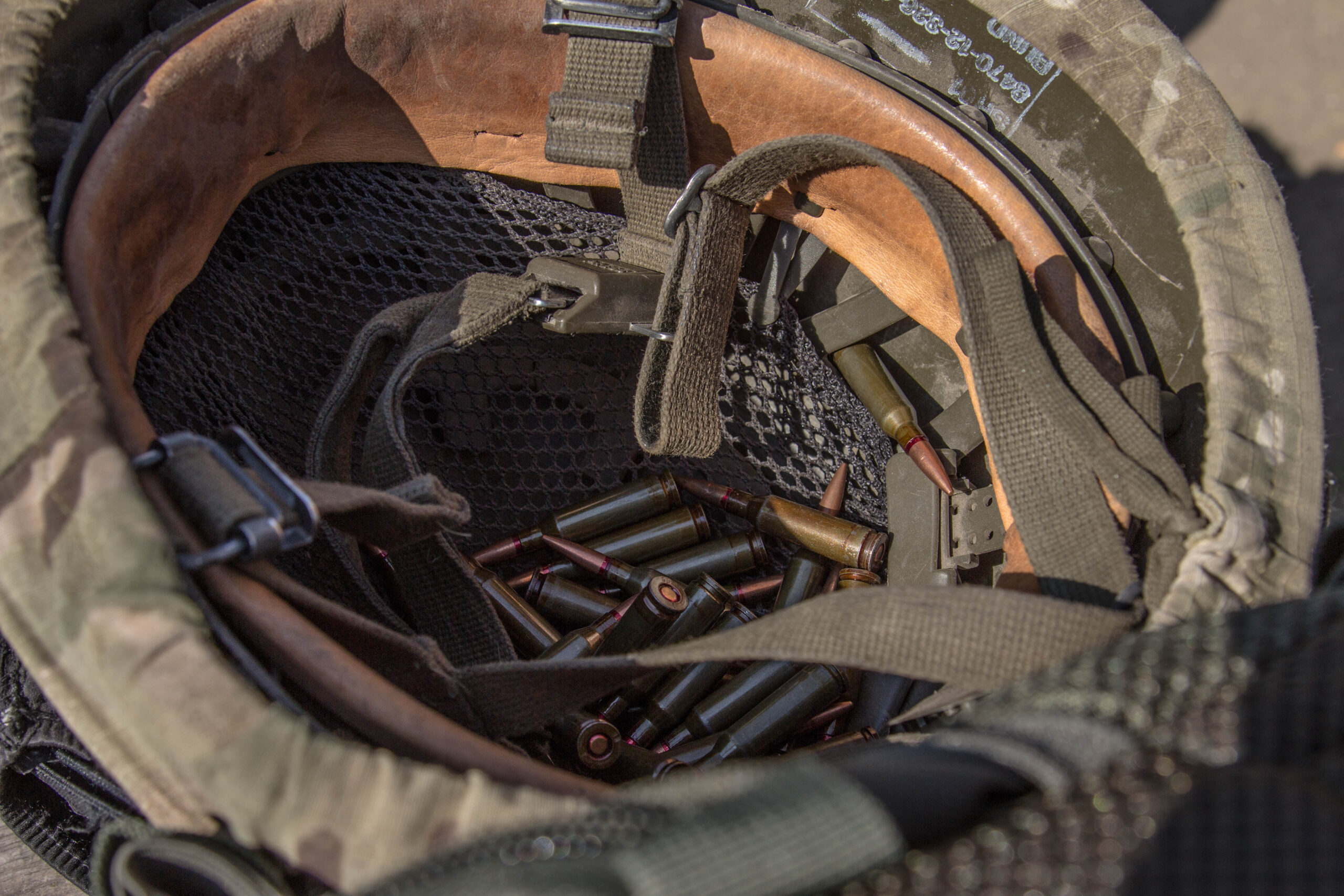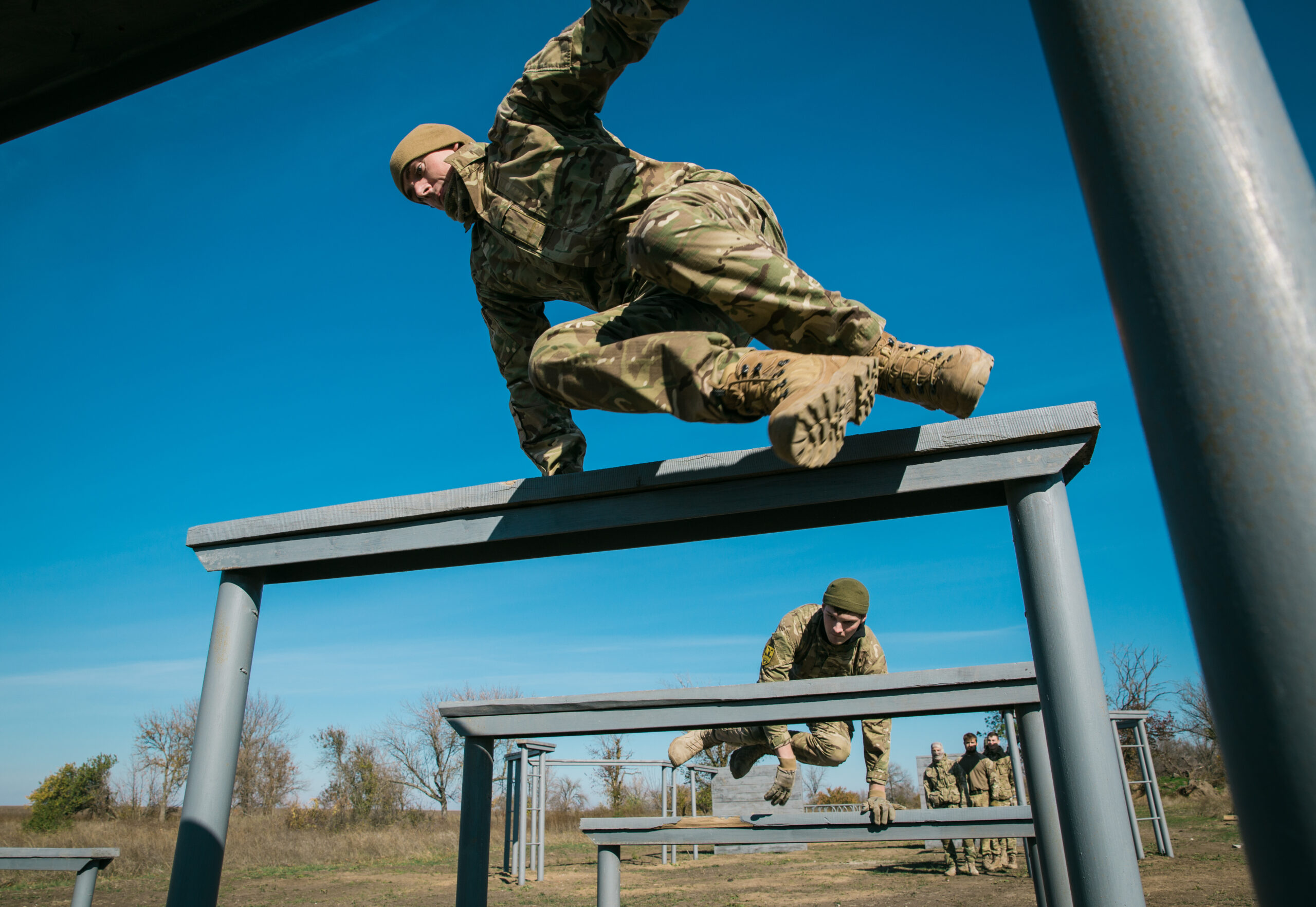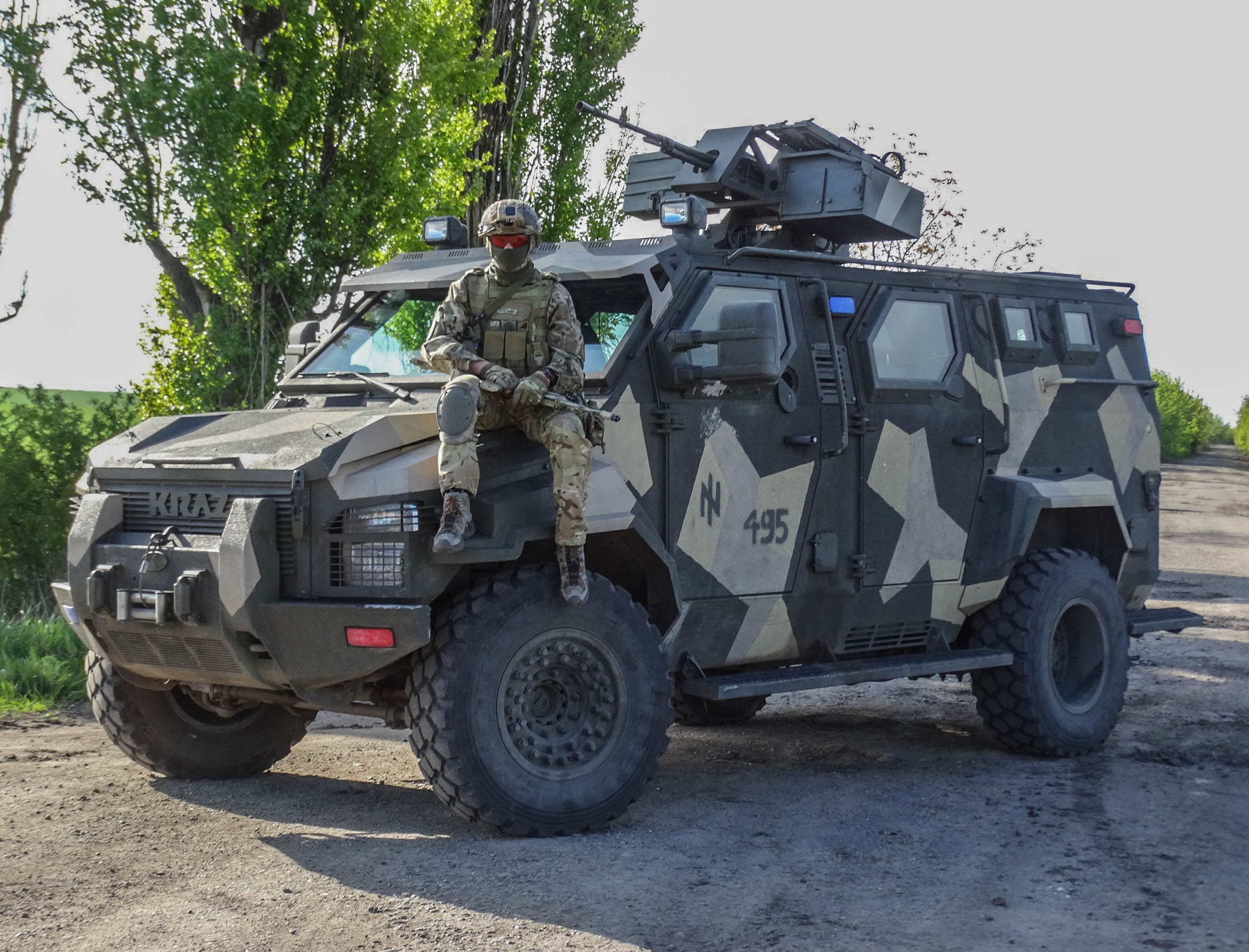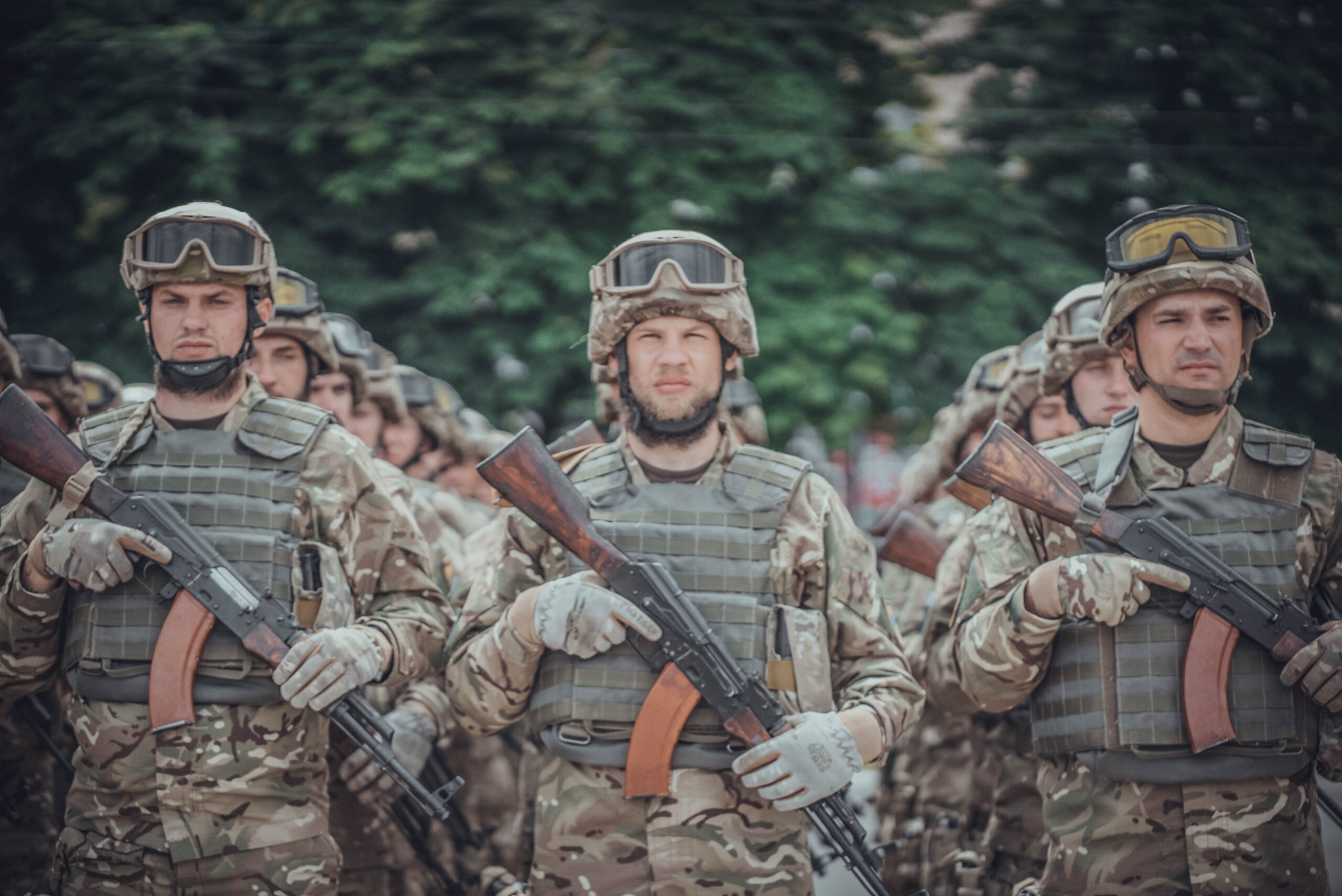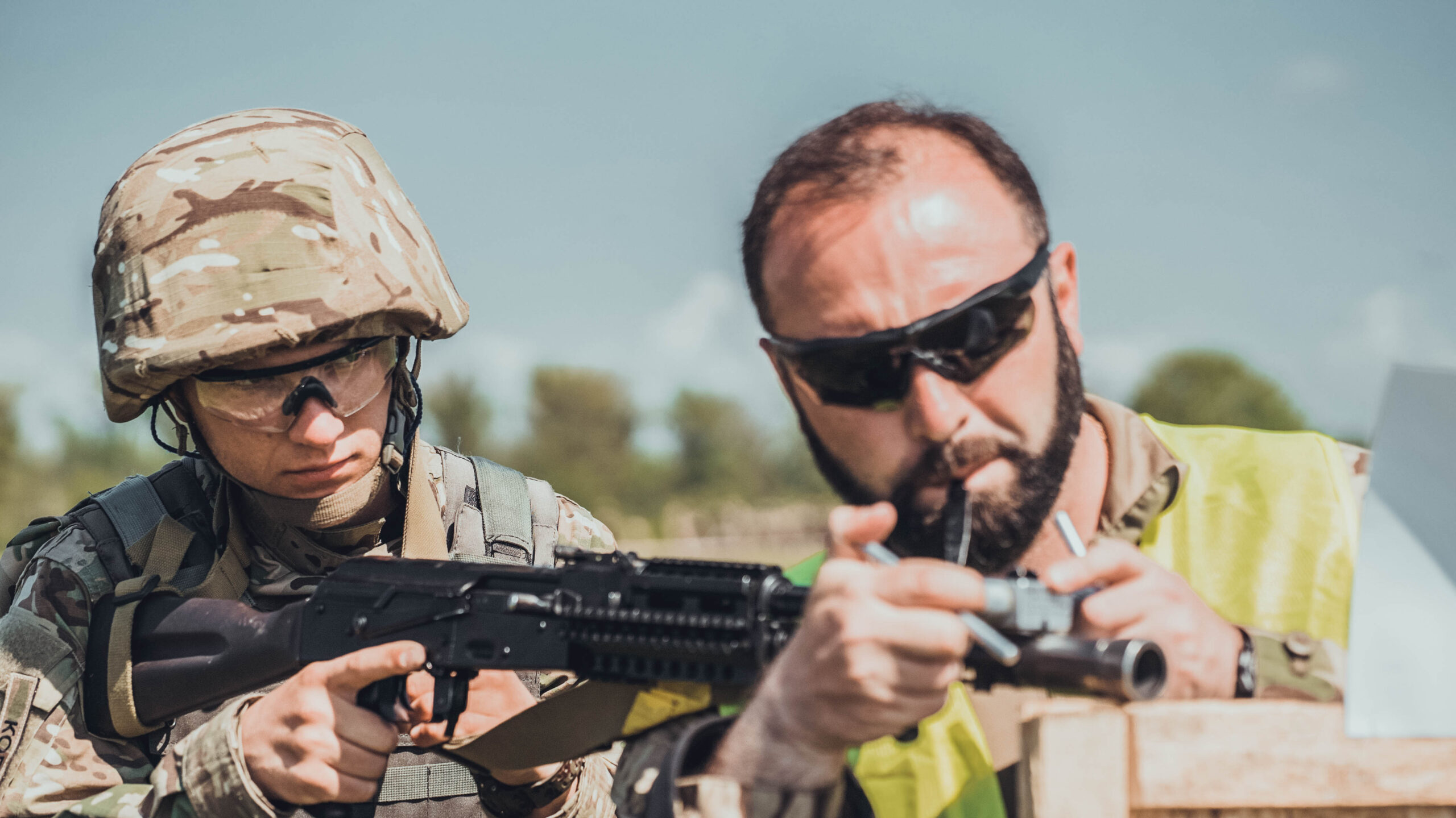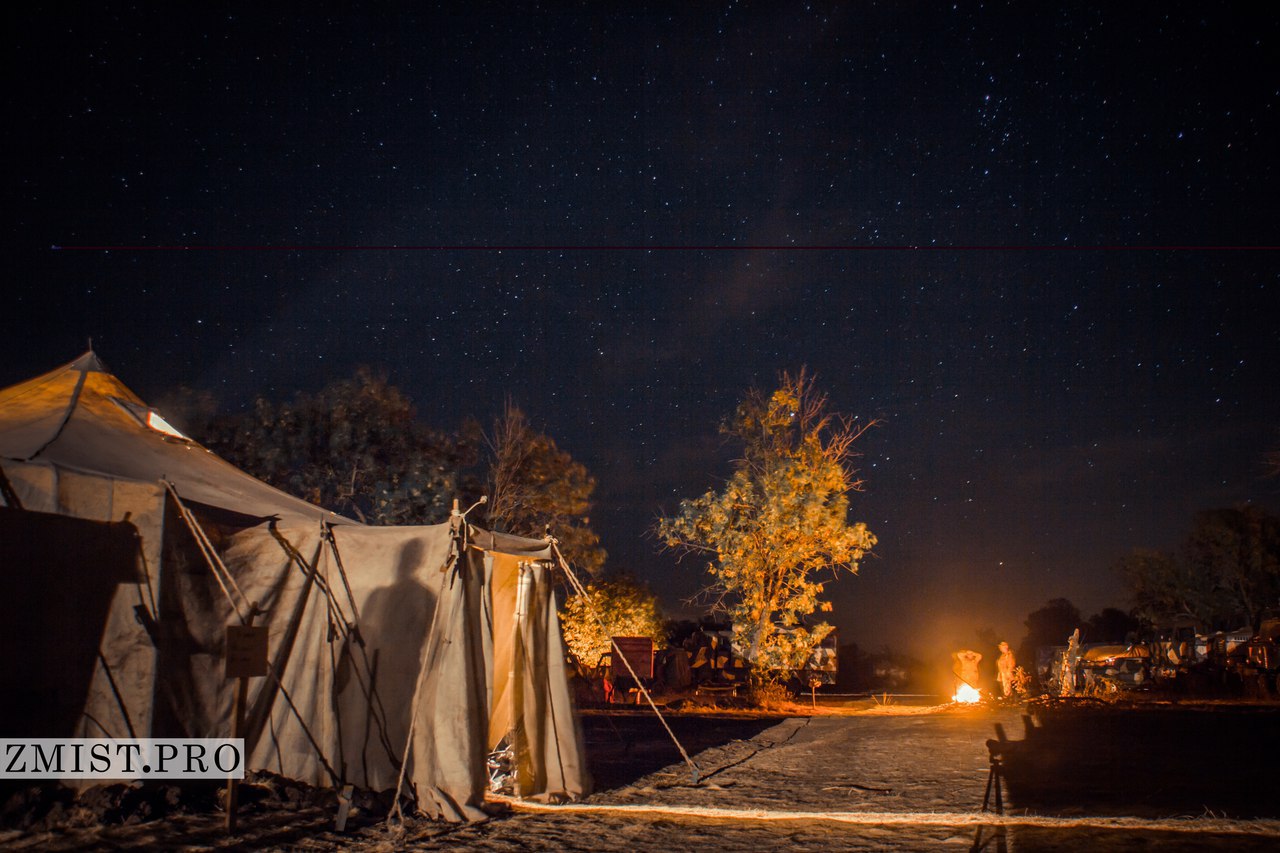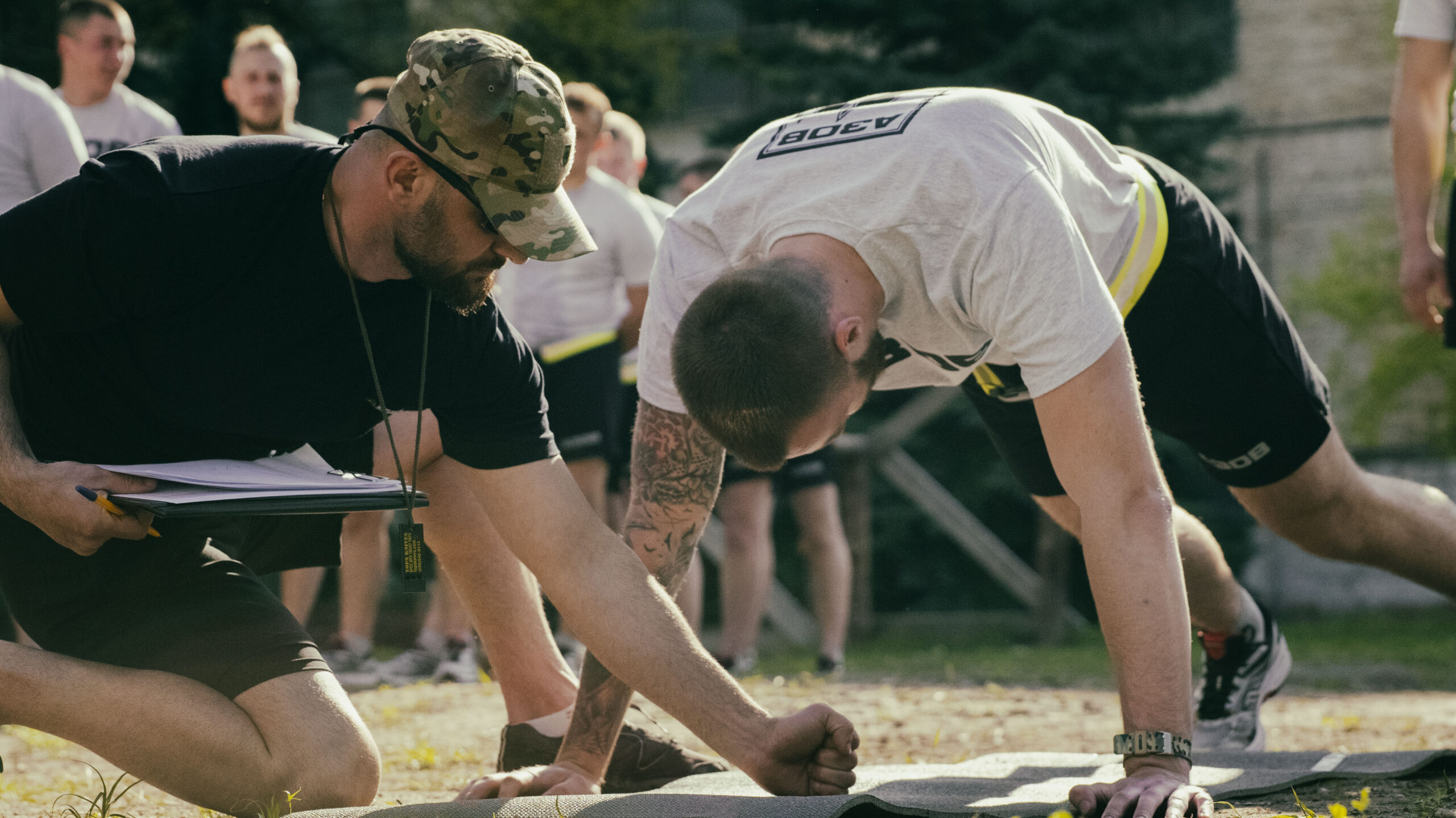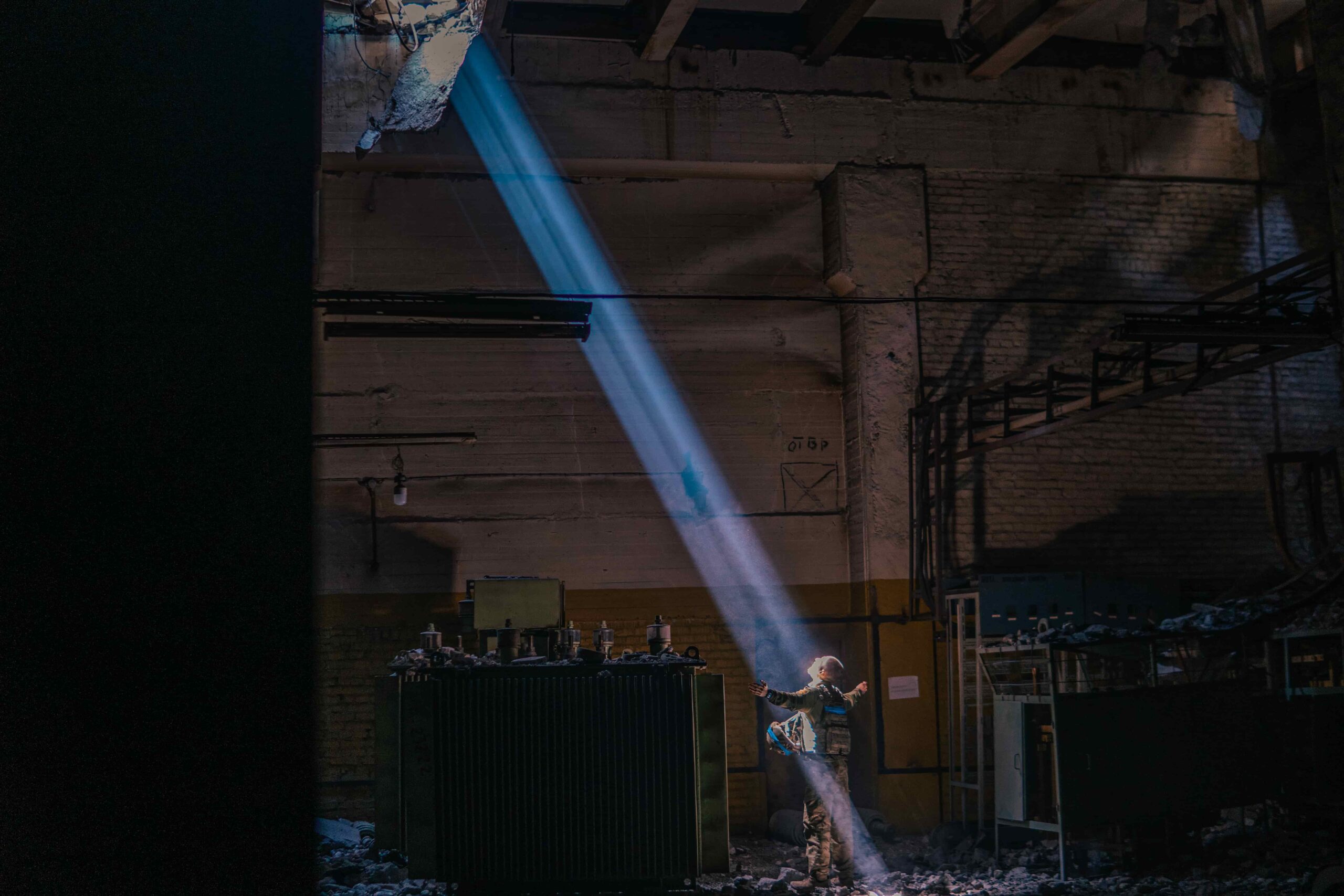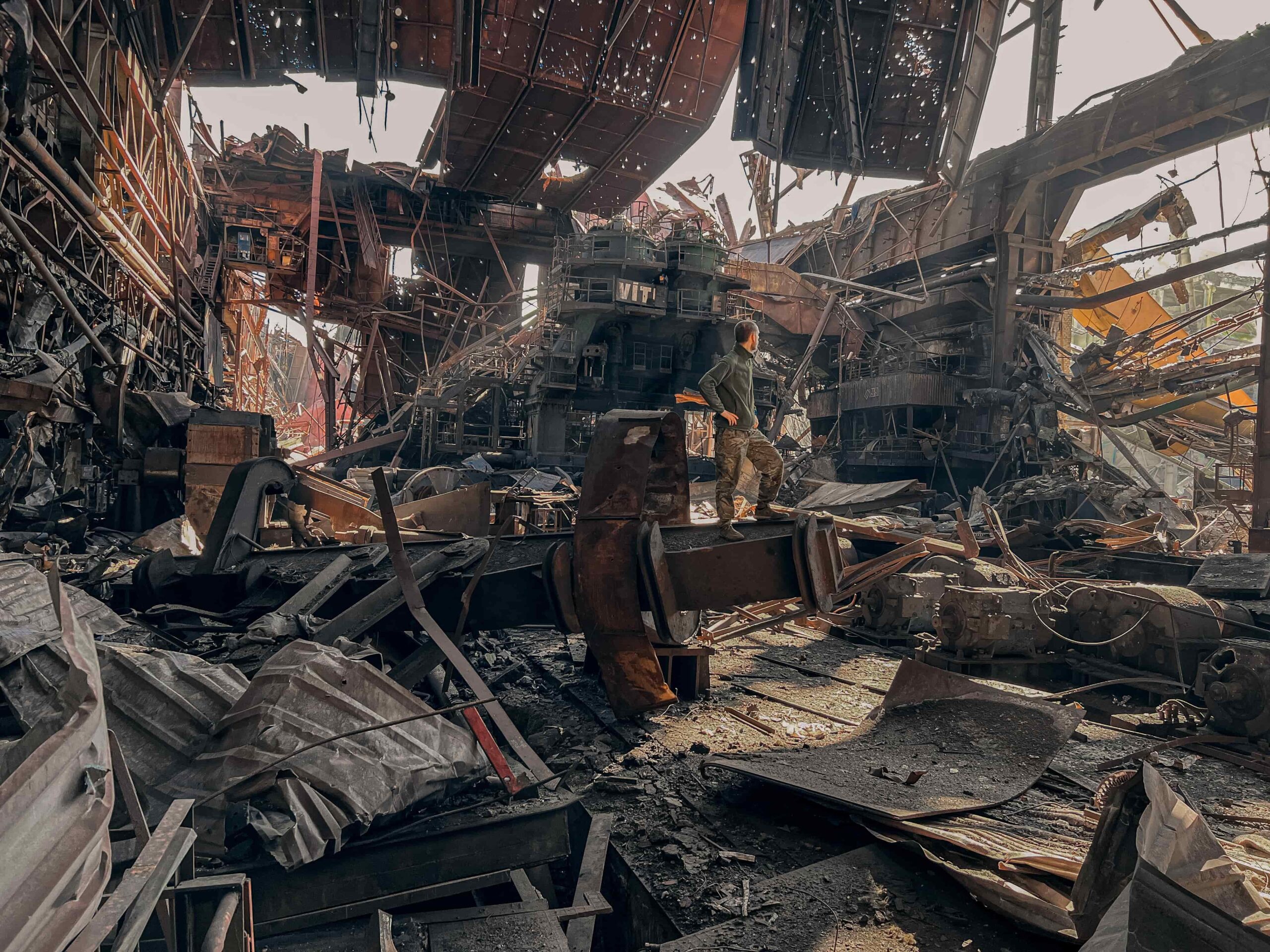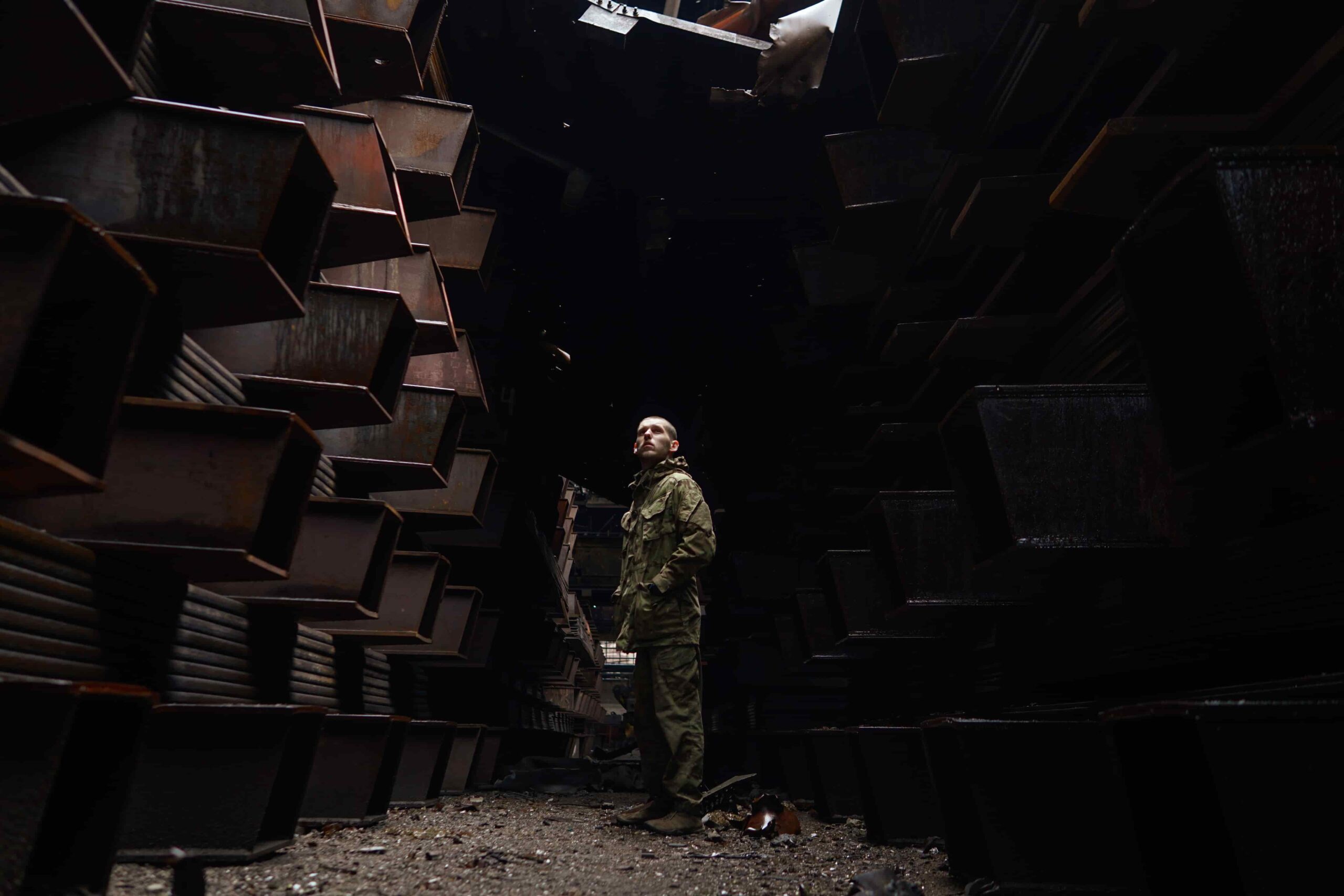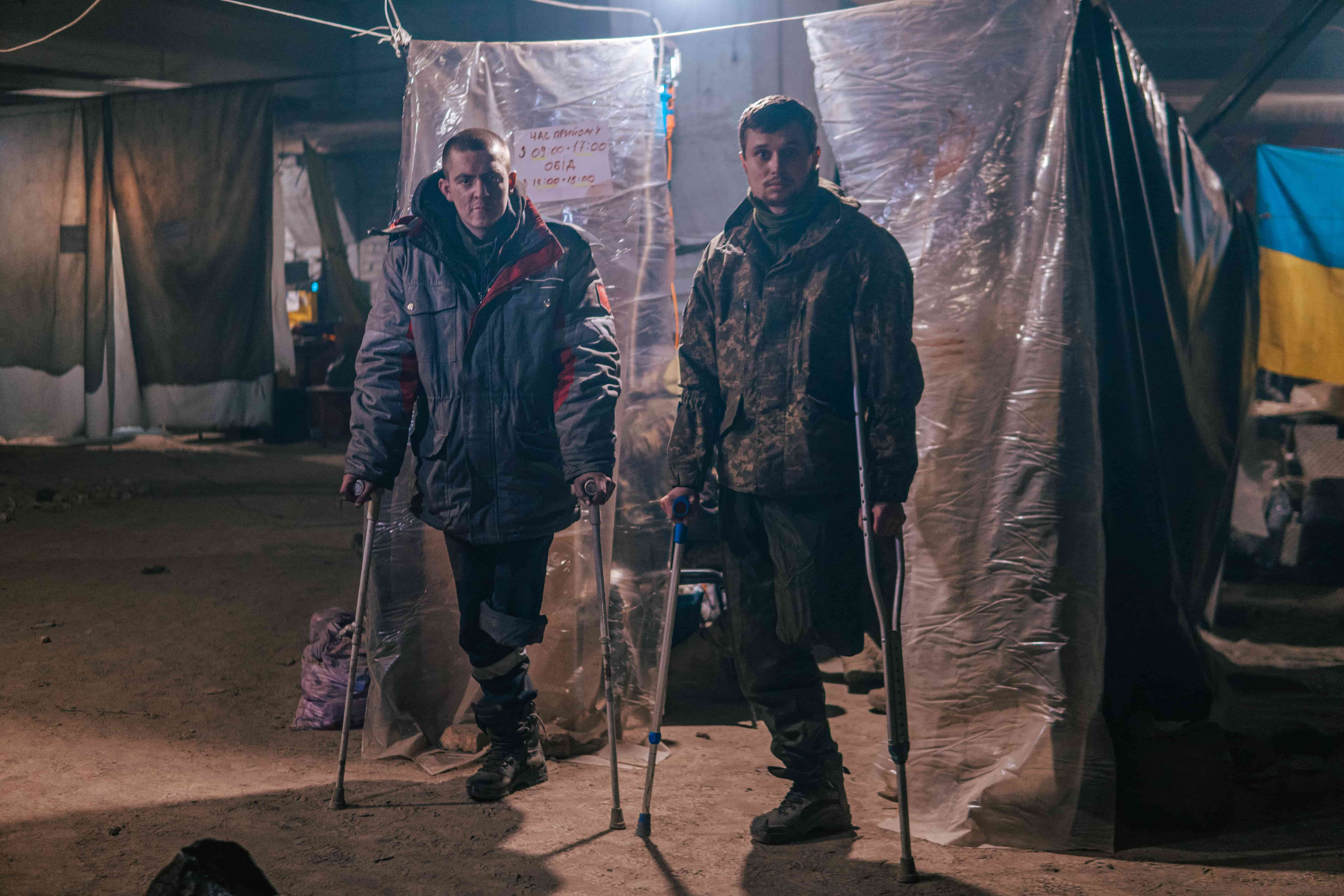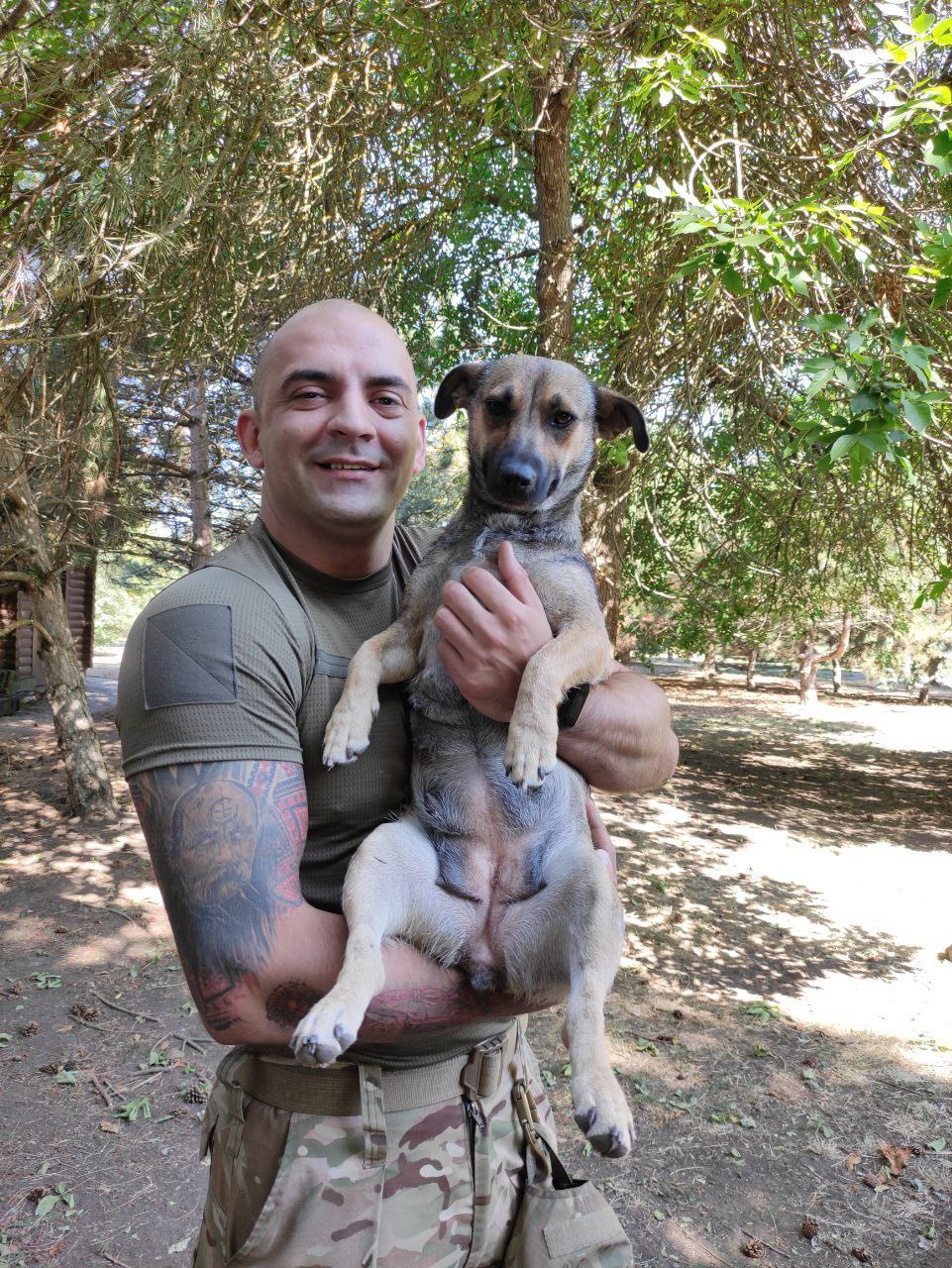Commander’s School
“Azov had a unique feature: the absence of professional officers initially posed challenges, but later it became an advantage and a distinctive trait. Azov managed to cultivate its own officers, and today all the officers are young individuals who were once part of the unit, many of them coming from Luhansk and Donetsk regions. It marked a departure from the Soviet legacy,” said Yuriy Mykhailchyshyn in an interview.
The youngest commander (“Redis”, 26 years old) and the youngest combat officer (“Akula”, 24 years old) among all Ukrainian defense forces serve in Azov.
After withdrawal from the front lines, the leadership faced the task of transforming the volunteer unit into a professional military formation. Years of training and combat coordination began. Command and staff training during the summer and fall of 2015 revealed apparent gaps in the knowledge of the personnel, prompting the development of a plan to address them:
“Four instructors from the United States and Canada were teaching. Two of them were Vietnam War veterans, aged 74 and 66. They fought in Vietnam as ordinary soldiers, then held command and staff positions in NATO structures in Iraq and Afghanistan. Such a course in the U.S. is designed for a year, but here they compressed it to two and a half months. The entire command staff of ‘Azov’ attended – 44 people. There was a lot of material in English that we couldn’t translate in time; it was in Russian, Ukrainian, and Georgian. But we coped, especially since ‘Azov’ had many officers fluent in English, and there was a military translator. Only two officers failed the final exams and left the course. Then, after completing the course with new knowledge, they went for combat coordination at the firing range… Then the war in the format of ‘face to face’ and ‘crowd against crowd’ ended, and we realized that urgently, non-military people needed to become military; otherwise, we would go in the wrong direction,”
— “Redis” commented to journalists.
Commander’s School
In the summer of 2015, the Military Commander’s School named after Colonel Yevhen Konovalets was established within the regiment, which started its operations in 2016. The school aimed to train the non-commissioned and senior ranks, providing volunteers with an opportunity to receive quality military education. It was the first specialized sergeant training school in the country, conducted according to NATO standards with enhanced physical and psychological preparation. The instructors of the School were officers from the Georgian army, many of whom acquired officer education under the “Green Berets” program in the United States and had significant combat experience. Therefore, when developing the curriculum, they combined Georgian, American, and Estonian service experience, adapting it to Ukrainian conditions.
The School began its operations in April 2016, with the first intake having only 50 cadets. By graduation in October, only 25 made it through.
Note: The head of the School is Georgiy Kuparashvili, a retired colonel of the Georgian army who has long been living in Ukraine and holds Ukrainian citizenship. In 2014, remembering the unpunished evil of Russian aggression against Georgia in 2008 and understanding that Russia would not stop in Crimea or Donbas, he started teaching Ukrainian soldiers military science. Georgiy Kuparashvili is referred to as the mentor of the brigade commander, Denys Prokopenko.
As part of the program, military disciplines and regulations were taught, along with humanitarian subjects. Special attention was given to the course on leadership and pedagogy because a sergeant must be able to pass on knowledge to their personnel. A sergeant should be an example in physical, intellectual, and psychological development.
“Experience in combat as a platoon leader, company commander, and combat officer provided an understanding of the requirements in forming the training center. Especially since constant cooperation with adjacent units, with staff officers, gave an understanding of the deplorable state of moral and technical decay in military science in our country. Taking this into account, the goal was set to combine the military experience of the ATO with modern military science, on the principles of which the School’s educational process is based. Differences in these positions are present, of course, but the principle of planning and implementing combat training is the same. From the first day, I felt the educational level of the sergeants and officers of the school; many of them were former members of the same unit where I was the commander of a company. I had something to compare, and the main difference was professionalism and military ethics, which is clearly lacking in today’s army,”
— commented the Chief of the Military School, “Kirt”.
If the Commander’s School started with several dozen sergeant graduates, over the years, it grew into a full-fledged training center. The school had three courses for sergeant preparation: the main course for platoon commanders, intermediate (preparation of deputy platoon commanders), and the course for sergeant instructors. Plans also included courses for officers of three levels: platoon, company, command-staff, and a separate course for training logistics specialists (S4\G4 sections), sergeants, and officers. It was also planned to train specialists in infantry heavy weapons, tactical medicine, mechanics-drivers, and armored vehicle commanders.
Initially, it was an unofficial initiative within Azov, but after demonstrating successes in retraining several courses of the unit’s soldiers, the command of the National Guard granted the Military School the status of a “Personnel Training Battalion” and expanded training for personnel from other brigades and operational units of the National Guard.
Note: The uniqueness of the School lies in the combination of advanced experience and standards of military education from Western countries with combat experience in the context of the Russian-Ukrainian war.
The Boot Camp
Azov started and continues to be a volunteer unit, recruiting only those who willingly join the service. However, not everyone is accepted into Azov. After an interview and checks, the candidate becomes a recruit. They undergo 5 weeks of intense training as part of the basic combat training course. After successfully passing exams, including general military, tactical, marksmanship, medical, engineering, and cartographic training, they can receive the Azov unit’s badge, acknowledging that they are now on par with other fighters.
2015-2016
In 2015-2016, the Boot Camp was called “Azov-Spartan”, referring to the famous warrior Greeks. At the end of two weeks of intense training, recruits faced a final exam, including a march-run, obstacle course, assault mountaineering, and ring wrestling. Finally, the fighter had to climb a rope to a height of three meters and strike a gong shaped like a Spartan helmet.
After receiving the badge as a sign of initiation, the newly minted fighter can choose a call sign, by which they will be called in the unit — before that, they go through the course under a serial number. Instructors of the boot camp emphasize that moral and volitional qualities are crucial for successfully completing the course. During the course, up to 50% of recruits are screened out — some morally give up, while others can’t cope with the physical load and can’t keep up with the required pace for learning new material. The overall criteria for evaluating physical fitness tests are among the highest in the Ukrainian army.
Why such a rigorous selection? In battle, you have to trust the person next to you, in front and behind you. You must trust your commander and unquestionably follow their orders. In case of injury, you should know that you will be pulled out, and you should be ready to help your comrade in any way.
In Mariupol in the winter of 2022, precisely during the boot camp, a full-scale invasion by Russia took place. Recruit Krzysztof Mushak, with the call sign “Zeus”, received his coveted chevron during the successful completion of combat tasks. Under heavy shelling, he carried one wounded comrade after another to cover.
Note: Recruits who score the most points during the Boot Camp and demonstrate themselves well in terms of morale and willpower qualities have the right to independently choose the unit they want to serve in; others are distributed at the discretion of instructors and unit commanders. After this, the recruit could start the process of joining the unit. However, their training and self-testing did not end there.
The Firing Range
When a soldier is not in combat, they train. This is a rule for any soldier. And for quality training, appropriate conditions are needed. So, Azov built a military firing range that met the most modern requirements. The range can accommodate 280 people training simultaneously.
On the range, there are:
- Modular barracks
- Squares
- Sports grounds
- Dining hall
- Training rooms
- Recreation area (one of the largest in the country)
- Separate recruitment corps
- Tactical fields for all types of weapons and calculations available in the unit
Azov Military Community
The initial composition of the battalion urgently needed not only military training from experienced instructors but also the creation of an informal internal military culture that encouraged the mastering of military science. However, this was not a particular problem for the leadership due to the competitive atmosphere within the collective. Simultaneously, this competitive spirit coexisted with the desire to share experiences. Almost from the beginning, Azov members began learning from each other and spreading the culture of handling weapons through video projects. For example, a fighter with the call sign “Sever” became one of the first Ukrainian military bloggers, recording video tutorials “Azov — Lesson” setting an example for many other military personnel.
A Bit About Recognition:
- In August 2019, the artillery calculation of the Azov Regiment became the best among the artillery units of the Joint Forces Operation. The Azov fighters also took the first place in their class among D-30 howitzers.
- Azov fighters won all prize places in shooting competitions among the fighters of the “Pivnich” volunteer battalion.
- Azov fighters participated in national competitions among the National Guard for the right to wear a beret with the blue award. For several years in a row, Azov fighters “Piston”, “Ashton”, and “Umpa”3 have been leading the National Guard in the competition.
Azov = Trendy
Azov fighters consistently maintained a reputation as the most “trendy” military personnel in the ATO zone. Primarily, this was due to the increased attention to upgrading personal firearms, wearing British Multicam instead of standard “dubok” and “pixel” camouflage. Instead of the given-out “Talans”, soldiers wore “Lowa” on their feet. Azov set a trend for tactical beards, while beards were prohibited in the Armed Forces of Ukraine. Tattoos were not prohibited in Azov. Everyone in “Azov” knew each other by call signs, following an old Cossack tradition. Finally, Azov members moved around the combat zone in pickups like the Mitsubishi L200, painted in the Azov “shrapnel” camouflage. Young, ideological, and well-built guys attracted a lot of female attention, intuitively drawing even more guys to the unit.
Press Service
Azov is not only known for its combat structures but also for its press service. In May 2022, Dmytro Kozatskyi, with the call sign “Orest”, the then head of the regiment’s press service, published photos from “Azovstal” that circled the world.
For many years, the unit’s press officers created media products, popularizing the unit and military service in the Ukrainian defense forces in general.
This had to be considered in light of the voluntary principle of unit formation. During the defense of Mariupol, the regiment’s press service was practically the only source of information about what was happening in the city.
Tactical Medicine
Any military training in Azov began with monotonous tactical-medical training and practicing the algorithm of tactical medicine protocols. One of the main tasks facing the medical service was to train each soldier in timely providing self and buddy aid. According to statistics, about 87% of deaths occur before the wounded person is delivered to a medical institution, and thus human lives often depend on the person providing assistance first, and on the battlefield, it’s either you or your comrade. Many military units still use a handbook on tactical medicine for special forces, compiled in 2016 based on a combination of training protocols from advanced armies worldwide with the practical combat experience of Azov.
The medical service of Azov is led by combat medic Yevhen Chudnytsiov, with the call sign “Chudyk”, who has been in Russian captivity twice — first after the Shyrokyne offensive operation in 2015 and secondly, due to the exit from Azovstal in 2022. As the head of the medical service, he established a unified model for the medical service, a single standard for unit first aid kits (according to the M.A.R.C.H. protocol), and supervised the continuous qualification improvement for combat medics. But the main thing was training in protocols and their implementation by every soldier in the unit. During the defense of Mariupol in the spring of 2022, this saved more than one life.
“The guys carried out the operation perfectly. I am grateful for the system we had in Azov, the medical service they created for us. Every Azov fighter was ready to stabilize the wounded. Thanks to this training, many of our wounded, who could have become very severe or even died, had their lives saved,”
— from the memories of Georgiy Kuparashvili regarding the defense of Mariupol.
But the story of helping each soldier in the unit does not end with injuries, successful evacuation, and handing over the wounded. In 2014, within Azov, a Patronage Service started operating, a unique rear structure that takes care of the wounded, prisoners, fallen, and their families. Essentially, this medical-volunteer structure created an additional bridge between the unit and state authorities to ease the traumatic experience for the fighter or family and take responsibility for certain bureaucratic aspects, financial support, treatment supervision, rehabilitation, or even burial. Such care and attention to each Azov member almost guaranteed their return to duty. This concern for the wounded strengthened the internal brotherhood of Azov as a unit, where everyone felt part of the Azov family.
“But what motivated me when I was severely wounded was that everyone cared for each other. A one-armed fighter, who had his arm amputated, with just one arm, barely standing the next day, fed his comrade. Walking fed the lying. They took care of natural needs. A family formed there. It used to be a unit, now it’s a team. But the team has come together as a family,”
— from the memories of Georgiy Kuparashvili regarding the defense of Mariupol.

